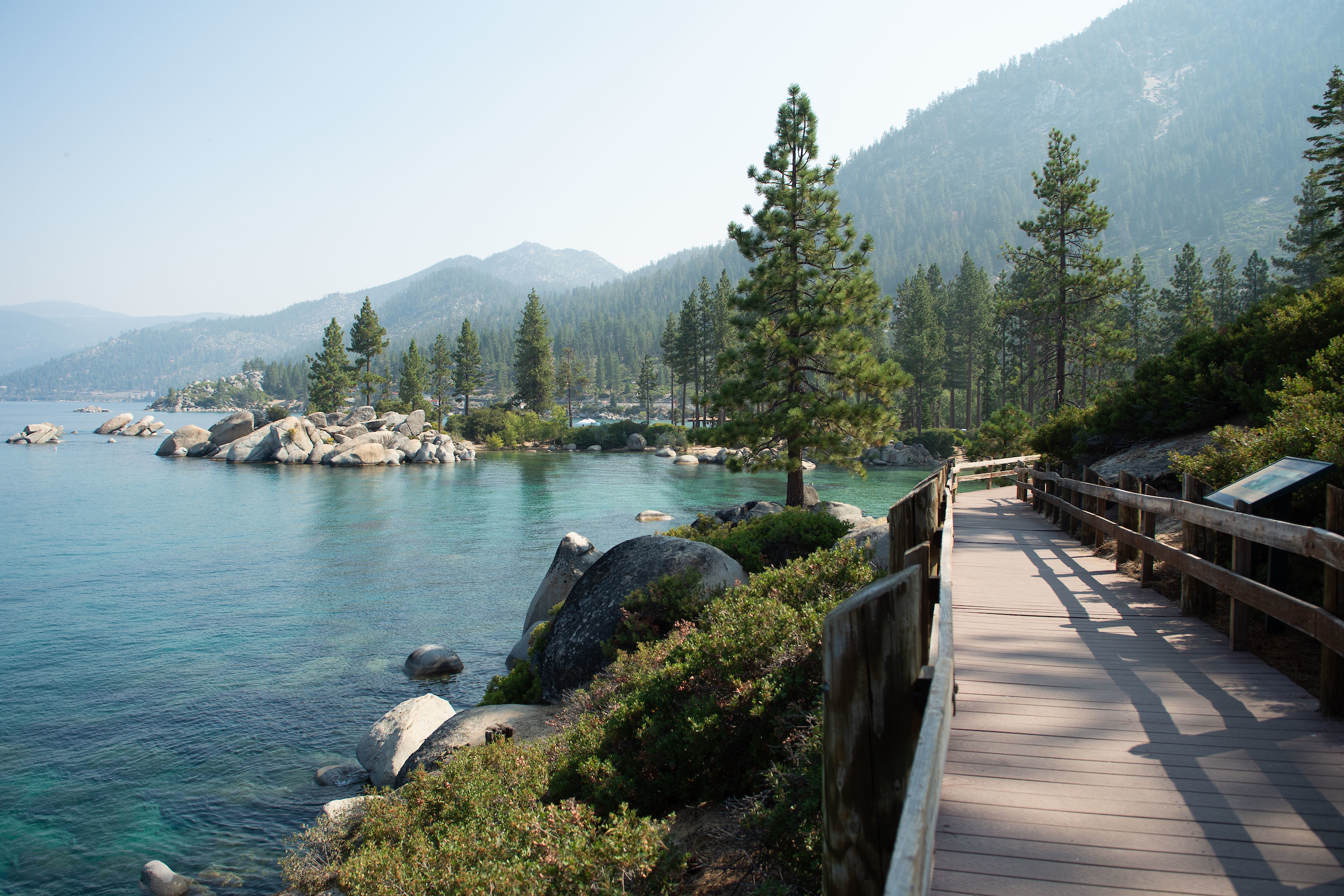Tahoe needs to be saved from watchdog agency created to protect it

All who have the good fortune to gaze upon Lake Tahoe’s magnificent clear cobalt waters sparkling at 6,200 feet ringed by granite mountains come away awestruck. The vast majority of those who live and visit the Tahoe Basin want to ensure Lake Tahoe remains unblemished for future generations to behold its natural glory.
Steep ravines and formerly healthy forests were once Tahoe’s best defense from massive development. Entrepreneurs first arrived to pillage Tahoe in the late 1800s. This was not long after the Comstock Lode discovery in nearby Virginia City, chronicled by Mark Twain.
In the 1950s, developers and county officials eager to exploit Tahoe’s scenery for revenue, casino tourism and tax windfalls further harmed the lake’s shoreline and basin. Greed, first called out in a 1964 California Law Review article remains an intractable force.
While many once campaigned to make Tahoe a national park, competing interests have always had money-making designs on Lake Tahoe. You could say the Tahoe Regional Planning Compact, which came about through a Congressional joint resolution in 1969, was a consolation prize to those who sought national park or monument status.
Central to the Tahoe compact’s original charter was the need to bring order and a science-based approach to Tahoe Basin land use management. A bistate agency, the Tahoe Regional Planning Agency (TRPA) established strict concepts of carrying capacity and environmental thresholds to protect the 207,000 acre Tahoe Basin, which straddles Nevada and California.
Nevada’s side now holds seven predominantly rural communities in three counties. California has one city (South Lake Tahoe) and eight rustic communities within two counties. Nearly 80 percent of the land is controlled by the U.S. Forest Service.
A new report earlier this month from the Tahoe Environmental Research Center extolled improvement in lake clarity, but the most dangerous invasive threat today remains real estate investors, developers and government officials hungry to exploit the lake’s environment.
There are dozens of new large developments in the works, many high-density luxury projects aimed at affluent visitors. All will move thousands of truckloads of dirt on narrow, rural roads and further strain Tahoe’s limited infrastructure and compromise air and lake quality.
TRPA, which began with a priority on resource conservation, has succumbed to the greed prophesied in 1964. TRPA is now mocked as “Tahoe Rich People’s Association.” Monied interests eager to build out the basin, along with their attorneys, now openly court or sit on TRPA committees. One luxury project — not yet TRPA approved — has been advertising for a year.
A new series, Selling Lake Tahoe, must have John Muir turning in his grave. Volunteer grassroots groups around the basin are mobilizing to pushback, but are woefully underresourced and overwhelmed by the volume of simultaneous projects.
In a recent call with TRPA’s public information officer, residents (me included) inquired about how and why developers are now able to use the formerly fiercely protective TRPA to get their way. We asked point blank: Why isn’t TRPA doing more to prioritize the lake’s long-term health and public safety? Because, we were told, “The developers are TRPA’s customers; there are 20 to 50 projects coming forward.” The answer dumbfounded us.
Imagine if regulatory agencies like the FDA said pharmaceutical companies are our customers, or the Federal Aviation Administration saw airplane manufacturers as their customers?
As Earth Day approaches, TRPA is in fundraising mode. Members of its executive staff started the year lobbying Congress for reauthorization of the Lake Tahoe Restoration Act and the hundreds of millions of dollars tied to it.
There’s a budget request for several million dollars before the Nevada Legislature. Meanwhile, California is responsible for millions more. And TRPA has received many grants.
Missing, however, is much-needed public scrutiny of whether TRPA, which has an operating budget of $22 million, is fulfilling its original charter to protect the largest Alpine lake in the U.S. and its fragile surrounding environment.
TRPA first turbocharged Tahoe tourism in 2004 when it approved short-term rentals as a permitted residential use — in defiance of local zoning — without an environmental impact assessment. Tahoe neighborhoods today are full of real estate investor-operated short-term rentals, party houses, with unattended barbecues and trash left for bears and other wildlife to plunder.
Not surprisingly, there’s now an acute housing shortage for school teachers, first responders and service workers.
Tahoe is being loved to death. It beat out the most visited (pre-pandemic) national park (the 522,419-acre Great Smoky Mountains National Park) by 2.5 times with nearly 25 million people. That number has skyrocketed to as many as 60 million trips, according to data from the Nevada and California departments of transportation.
Sightseers clog or park haphazardly on the lake’s two-lane ring road. Missing from many visitors’ mindset is a “pack it in and out” mentality. Visitors routinely roll coolers full of drinks off clearly marked trails and bivouac on once pristine beaches, leaving behind trash, toilet paper, dog waste and plastic debris in and along the lake’s edge.
As Tahoe’s been so severely overwhelmed, travel guide Fodor’s took pity and advised would-be visitors to take a pass on this mountain lake destination this year. Overseeing visitor access, one would think, is within the purview of the powerful bistate agency and government officials charged with safeguarding the lake’s precious ecosystem and the people.
Apart from overtourism and entrepreneurial plundering, Lake Tahoe, its communities, and visitors also face an existential threat. Wildfires are now an annual occurrence within Lake Tahoe’s Sierra Nevada forests. These forests hold “zombie” trees with little hope of regenerating as the climate warms, according to a new study.
All rely on narrow roads, some subject to falling boulders and avalanches. While locals, year-round, have resigned themselves to gridlock, 2021’s immense Caldor wildfire and extreme weather highlight just how critical the already overburdened roadways are to public safety.
Yet, TRPA now works hand in hand with developers eager to bring more tourists into the basin touting its public-private collaborations. The Sierra Club filed a lawsuit against TRPA in February 2013 for multiple violations of the Tahoe Regional Planning Compact.
With hundreds of millions of dollars and Lake Tahoe’s future on the line, we must consider some difficult questions:
- Why hasn’t TRPA completed a comprehensive Environmental Impact Review and carrying capacity study since the 1980s? (Today, TRPA relies on developers to submit a project environmental checklist.)
- Has TRPA’s leadership and its highly compensated staff fallen prey to “regulatory capture” (where the agency is now dominated by the industries and interests it is charged with regulating)?
- Academic studies now conclude expansion into wildlands creates a double hazard zone. Why is there no independent basinwide analysis of the cumulative impact of all the proposed and approved development around the Lake?
- Where is the basinwide evacuation plan that covers the millions of visitors and locals at risk when the next wildfire or other emergency occurs?
It’s not too late for Lake Tahoe if we still agree with the prescient California Law Review: “A thriving metropolis characterized by towering skyscrapers and blazing neon signs is no more appropriate at Tahoe than at Crater Lake, Yellowstone, Yosemite, or other of the nation's exceptional physical assets.”
TRPA began with a priority on resource conservation. Tahoe needs that focus more than ever. To paraphrase Joni Mitchell, let’s not pave more of paradise to put up luxury hotels and condos.
Pamela Mahoney Tsigdinos is a writer and full-time Tahoe resident who volunteers with grassroots Tahoe Basin groups working to protect Lake Tahoe.
